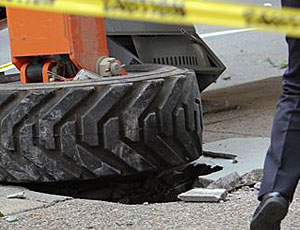Federal safety regulators in Philadelphia are eyeing a fiber-reinforced sidewalk vault cover as the smoking gun that caused an aerial work platform (AWP) to tip over, killing the operator and injuring three bystanders. The accident also is raising eyebrows over the proper use of AWPs and whether or not they are regulated vigorously enough.

On Oct. 12 in downtown Philadelphia, 41-year-old James Wilson was using the 125-ft-tall AWP to inspect the facade of the city’s First Presbyterian Church. Investigators believe Wilson, who was running the unit on an urban sidewalk, drove over the vault lid with the boom extended. The lid collapsed under the weight of the 20-ton machine, throwing the machine off balance and causing it to tip over. “He was very experienced,” says Brent Schopfel, owner of Masonry Preservation Group Inc., Merchantville, N.J., which employed Wilson for more than 20 years. “Forget the employee part—he was a friend. Our company is grieving.”
The lid that collapsed is a common sidewalk covering made of “a composite fiberglass” material, says Al D’Imperio, Philadelphia-area director of the U.S. Occupational Safety and Health Administration. “We are looking at all aspects of the site,” he adds.
City officials say the vault cover, about 1 ft wide, 2 ft long and owned by cable company Comcast, was up to code. “There is no existing regulation currently, but there are industry standards—and I believe Comcast was following those,” says Maura Kennedy, spokeswoman for Philadelphia Mayor Michael Nutter (D). She adds that the masonry contractor did not have a permit to operate the AWP on the sidewalk where the failure occurred, but it did have one for the sidewalk around the corner. “We will be assessing our own violations after we read the OSHA report,” Kennedy says. “Construction vehicles all across the city navigate these obstacles with great care on a daily basis.” She also notes that a common solution that contractors use is to cover the hole with steel plates.
Wilson, a professional tuck-pointer who belonged to bricklayers’ union Local 1 of Pennsylvania and Delaware, was strapped into the lift with a full-body harness, says his employer. The fall protection did not save him.
Operators wear such harnesses “exclusively for the concern of ejection,” notes Tony Groat, executive vice president of AWPT Inc., a Schenectady, N.Y.-based safety institute and North American subsidiary of the International Powered Access Federation, which issues training certificates to AWP operators. If the boom deflects or bounces, harnesses keep workers from catapulting out of the lift, but “nobody has designed anything to protect the worker if the boom falls,” adds Schopfel.
Ground Control
Whether or not Wilson took the vault cover into consideration before operating the machine is unknown, but it is a key issue that should be addressed in training, safety experts say. “I’ve run [and] rerun this 150 times through my mind,” says Schopfel. “The bottom line is that the T’s were crossed and the I’s were dotted. This was a freak thing.”
Even so, AWP operators frequently are not trained on how to properly assess safe ground conditions. Says Groat, “The operator is in control of the machine. He has the fundamental responsibility to make sure where he is driving is adequate, and if he is not sure, then go and have someone approve it.”
One problem is AWPs often are confused for cranes and have different operating characteristics. After this recent accident, early news reports stated that AWPs are not supposed to be driven from the air.
Industry experts counter that is not the case. A source at JLG, the lift’s manufacturer, told ENR that AWPs like the one that fell in Philadelphia are designed to be driven from the platform and that the machine, a Model 1250AJP, was not defective.
“They can be driven all the way up, given the conditions are proper,” said a JLG spokesman, who would not...


Post a comment to this article
Report Abusive Comment